Subclass Acari
- Ticks and mites
- Most very tiny (< 1 mm), except for ticks
- Some are external parasites
- Very diverse; typically divided into two or more orders or superorders
- • Parasitiformes are the ticks and various mostly parasitic mites
- • Acariformes are a large, diverse group of mites (including parasitic forms)
- May be polyphyletic
|
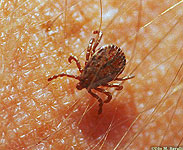
Hard Tick, Dermacentor sp. (O. Parasitiformes); CA; a blood-feeding parasite
|
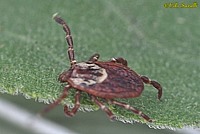
American Dog Tick, Dermacentor variabilis (O. Parasitiformes); NE
|
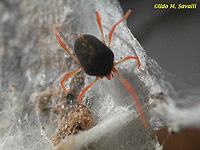
Blue Oat Mite, Penthaleus sp. (O. Acariformes); AZ; feeds on plants
|
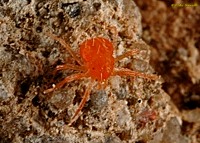
Whirligig Mite, Anystis sp. (O. Acariformes); AZ; aquatic
|
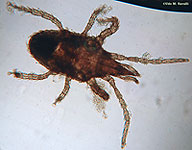
A predatory Snout Mite (Family Bdellidae, O. Acariformes), AZ
|

Prostigmatid (left) & Oribatid (right) Mites (O. Acariformes); AZ; from leaf litter
|
|
Order Araneae
- Spiders
- 36,000 Species
- Most are predators
- Chelicerae modified into venom fangs
- Silk glands and spinnerets
|

Western Black Widow, Lactrodectus hesperus, female in ventral view
See also labeled photo.
|
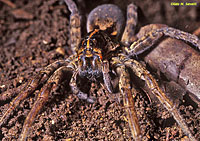
Wolf Spider, Hogna sp. (Lycosidae); KY
See also labeled photo.
|
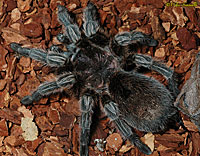
Chilean Rose Tarantula, Grammastola rosea; tarantulas are large, primitive spiders
|
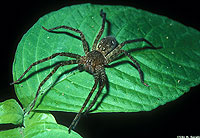
Nursery Web Spider, Thaumasia
sp.; Ecuador
|
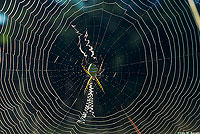
Banded Garden Spider, Argiope trifasciata; Kenya
|
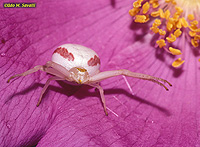
Goldenrod Crab Spider, Misumena vatia; ME
|
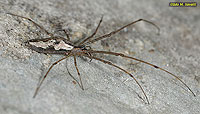
Long-jawed Orb Weaver. Tetragnatha sp. (Tetragnathidae); AZ
|
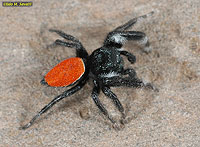
Jumping Spider Phidippus sp. (Salticidae); AZ
|

Marbled Cellar Spider Holocnemus pluchei (Pholcidae); AZ (introduced from Mediterranean region)
|
|
Order Opiliones
- Harvestmen & Daddy-Long-Legs
- Prosoma & opisthosoma fused (no pedicel)
- Small bodies but very long legs
- Predators or scavengers
- 1 Pair of eyes
- Reduced chelicerae
|
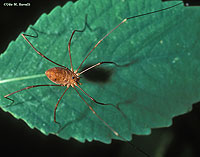
Harvestman, Hadrobunus sp.?; KY
|

Desert Harvestman, Eurybunus sp.; AZ
|
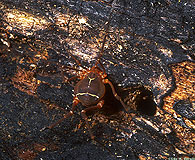
Ornate Harvestman, Vonones sayi; KY
|
|
Order Scorpiones
- Scorpions
- Abdomen divided into Mesosoma and "tail"
- Large pedipalps form pincers (chelae)
- Venomous stinger at end of tail
- Reduced chelicerae
|
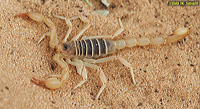
Northern? Scorpion, Paruroctonus boreus?; UT
See also labeled photo.
|
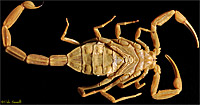
Arizona Bark Scorpion, Centruroides sculpturatus, ventral side of dried specimen
See also labeled photo.
|
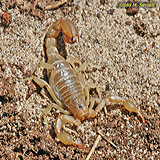
Arizona Striped-tail Scorpion, Vaejovis spinigerus; AZ
|
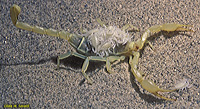
Coachella Valley Sand Scorpion, Paruroctonus mesaensis; carrying young.
|

California Forest Scorpion, Uroctonus mordax; CA
|
|
Order Pseudoscorpiones
- Pseudoscorpions
- Large pedipalps form pincers (chelae)
- Abdomen lacks elongated "tail" and stinger
- Size tiny; often phoretic on beetles
|
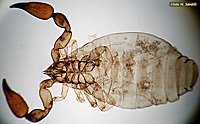
Pseudoscorpion, whole mount microscope slide
|
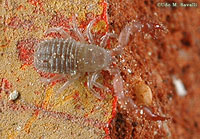
Pseudoscorpion; AZ
|
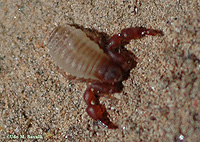
Pseudoscorpion; AZ
|
|
Order Solifugae or Solpugida
- Sunspiders or Windscorpions
- Very large forward-pointing chelicerae
- Appear to have 5 pairs of legs: the anterior pair is actually enlarged leg-like pedipalps used as feelers
- Fast-running predators
|
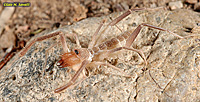
Straight-faced Wind Scorpion, Eremobates sp.?, male; AZ
|
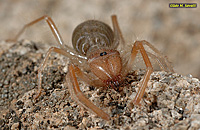
Straight-faced Wind Scorpion, Eremobates sp.?, female; AZ
|
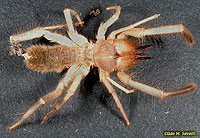
Sun Spider, Eremocosta sp.?; dried specimen
|
|
Order Amblypygi
- Tailless Whipscorpions
- Pedipalps with spikes but not jointed chelae
- Flattened body
- First pair of walking legs extremely long (at least several times length of other legs) and function as feelers
- Lack telson
|

Sonoran Whipscorpion, Paraphrynus mexicanus (native to southern Arizona)
|
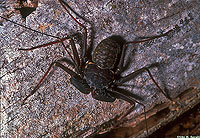
Florida Whipscorpion, Phrynus marginemaculatus; FL
|
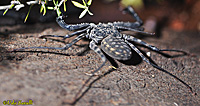
African Whipspider, Damon variegatus
|
|
Order Uropygi
- Whipscorpions or Vinegaroons
- Enlarged pedipalps but with reduced chelae
- Flattened body in most
- First pair of walking legs longer and slenderer than others, act as feelers
- Posterior end with a thin, straight telson that squirts acetic acid
- Short-tailed whipscorpions are small (<5 mm), tropical species with very short telson; sometimes placed in their own order, Schizomyida
|
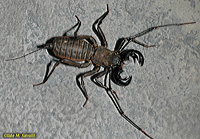
Philippine Vinegaroon, Minbosius manilanus
|
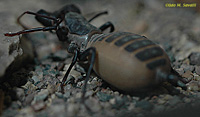
Giant Vinegaroon, Mastigoproctus giganteus
|

Short-tailed Whipscorpion, Schizomus floridanus, preserved specimen
|